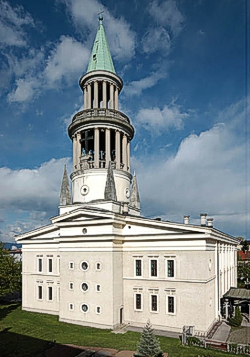
Josip Plečnik significantly influenced the face of Prague, Vienna, and his native Ljubljana
 |
Plečnik, a student of Vienna's professor Otto Wagner, came to Prague before World War I to teach architecture and gained a good reputation. After the establishment of the republic, Plečnik's task became to fulfill Masaryk's requirement to "transform the monarchist castle into a democratic castle". Plečnik got along very well with the president-liberator, Masaryk had full confidence in him and entrusted him not only with the modifications of the Prague Castle, which had been neglected since the time of Rudolf II, but also with his favorite residence in Lány.
At Prague Castle, Plečnik began at the very beginning of the 1920s with sensitive changes to the South Gardens, which were recommended to him by the Association of Fine Artists Mánes after the declared competition for their modification failed. The modest yet noble solution, respecting the castle's genius loci, opened the way for Josip Plečnik to further commissions for the presidential office - for which he never accepted any fee. He claimed that the task itself represented the greatest honor for him.
At Masaryk's suggestion, Plečnik then became the official castle architect, while at the same time he was also appointed a professor of architecture at the newly established university in Ljubljana, thus having to divide his interest between both cities. He mostly created designs for Prague Castle in Slovenia and entrusted oversight of their implementation to his student Otto Rothmayer. Nevertheless, Plečnik did not shy away from personal oversight and regularly came to Prague in the summer to check the completed work with his own eyes.
The traces of nearly fifteen years of collaboration between both architects can still be seen at Prague Castle today, often sensitively restored after 1989. According to Plečnik's plans, the garden Na Baště was modified, along with three of the four castle courtyards; he also designed Masaryk's lookout with a vineyard on the northern edge of the Jelení příkop. He also projected the interior of the Column Hall in the northern castle wing, President Masaryk's apartment in the New Royal Palace, or modifications to the president's country residence at the castle in Lány.
However, Plečnik's efforts for urban modifications of the surrounding area of the Castle did not materialize, mainly due to the resistance of the club Za starou Prahu and Antonín Engel, the author of urban planning concepts for the new Dejvice. However, he significantly influenced the face of the city at the other end of Prague, in Vinohrady, where the Church of the Most Sacred Heart of Our Lord was built according to his plans between 1928 and 1932. The modern building, reminiscent of ancient temples, is today a national cultural monument and is also vying for inclusion on the UNESCO World Heritage List.
Plečnik's Prague mission ended in the mid-1930s, as he increasingly became a target of nationalistic attacks. Articles appeared in newspapers about the "foreigner destroying the sacred seat of Czech kings," and Plečnik, who could no longer receive the necessary support from the ailing President Masaryk, ultimately remained at home in Ljubljana. The infamous end of his Prague involvement somewhat resembles his departure from Vienna to Prague a quarter of a century earlier.
The talented architect first drew attention to himself after graduating from the Vienna Academy of Fine Arts with the monumental Zacherl Palace, completed in 1905. The building, with its reinforced concrete structure, is often considered one of the first modern buildings in Vienna. However, six years later, he encountered the conservative public, which included Emperor Franz Joseph I, with the starkly designed Church of the Holy Spirit in Ottakring. He thus gladly accepted the offer from his classmate Jan Kotěra, who facilitated a professorship for him in Prague.
Plečnik spent the last two decades of his fruitful life in Ljubljana, where he not only established the School of Architecture but also significantly influenced the urban planning of the city. For many years, Plečnik's work remained overshadowed by that of more famous colleagues, such as Le Corbusier, Mies van der Rohe, or Alvar Aalto. A turning point in the perception of his work came with an exhibition organized in 1986 by the Centre Pompidou in Paris, which documented his work and brought him to a wider audience.
The English translation is powered by AI tool. Switch to Czech to view the original text source.
0 comments
add comment
Related articles
0
03.01.2018 | Sloveni want to get Plečnik's buildings into UNESCO themselves, without the Czech Republic
0
19.05.2017 | The exhibition will present two Plečnik buildings in Prague and Vienna
0
22.01.2017 | Slovenian architect Josip Plečnik was born 145 years ago
0
04.01.2017 | <Request for the inscription of Plečnik's Church on UNESCO will probably be submitted next year>
0
25.01.2016 | The committee is preparing the nomination of Plečnik's buildings for UNESCO
0
04.01.2007 | Plečnik created little in Prague, he did not want to take work from his Czech colleagues
0
04.01.2007 | Josip Plečnik transformed Prague Castle and the appearance of his hometown Ljubljana










